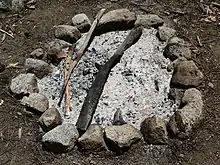Wood ash
Wood ash is the powdery residue remaining after the combustion of wood, such as burning wood in a fireplace, bonfire, or an industrial power plant. It is largely composed of calcium compounds along with other non-combustible trace elements present in the wood. It has been used for many purposes throughout history.

Composition
Variability in assessment
Many studies have been conducted regarding the chemical composition of wood ash, with widely varying results. Calcium carbonate (CaCO3) is the major constituent at temperatures below 750°C(small fireplace).[1] At temperatures above 750°C (big furnance) calcium oxide (CaO) is the major constituent.[2] Some elements in wood ash: Fe 1,6-55 g/kg, Si 6-170 g/kg, Al 1,2-45 g/kg, Mn 1-20 g/kg, As 0,6-50 ppm, Cd 0,18-60ppm, Pb 2-500ppm, Cr 12-280ppm Ni 10-140ppm, V 1,8-120 ppm. A comprehensive set of analyses of wood ash composition from many tree species has been carried out by Emil Wolff,[3] among others.
Several factors have a major impact on the composition:
- Fly ash: Some studies include the solids escaping via the flue during combustion, while others do not.
- Temperature of combustion[4] produces two direct effects:
- Dissociation: Conversion of carbonates, sulfides, etc., to oxides results in no carbon, sulfur, carbonates, or sulfides. Some metallic oxides (e.g. mercuric oxide) even dissociate to their elemental state and/or vaporize completely at wood fire temperatures.
- Volatilization: In studies in which the fly ash is not measured, some combustion products may not be present at all.
- Experimental process: If the ashes are exposed to the environment between combustion and the analysis, oxides may convert back to carbonates by reacting with carbon dioxide in the air.
- Type, age, and growing environment of the wood stock affect the composition of the wood, and thus the ash.
Measurements
Typically between 0.43 and 1.82 percent of the mass of burned wood (dry basis) results in ash.[4] Also the conditions of the combustion affect the composition and amount of the residue ash, thus higher temperature will reduce ash yield.[5]
Much wood ash contains calcium carbonate as its major component, representing 25[6] or even 45 percent.[1] Less than 10 percent is potash, and less than 1 percent phosphate; there are trace elements of iron, manganese, zinc, copper and some heavy metals.[6] However, these numbers vary, as combustion temperature is an important variable in determining wood ash composition.[4] All of these are, primarily, in the form of oxides.[4]
Uses
Fertilizers
Wood ash can be used as an organic fertilizer used to enrich agricultural soil nutrition. In this role, wood ash serves a source of potassium and calcium carbonate, the latter acting as a liming agent to neutralize acidic soils.[6]
Wood ash can also be used as an amendment for organic hydroponic solutions, generally replacing inorganic compounds containing calcium, potassium, magnesium and phosphorus.[7]
Composts
Wood ash is commonly disposed of in landfills, but with rising disposal costs, ecologically friendly alternatives, such as serving as compost for agricultural and forestry applications, are becoming more popular.[8] Because wood ash has a high char content, it can be used as an odor control agent, especially in composting operations.[9]
Pottery
Wood ash has a very long history of being used in ceramic glazes, particularly in the Chinese, Japanese and Korean traditions, though now used by many craft potters. It acts as a flux, reducing the melting point of the glaze.[10]
Soaps
Potassium hydroxide can be made directly from wood ash[11] and in this form, is known as caustic potash or lye. Because of this property, wood ash has also traditionally been used to make wood-ash soap.
Bio-leaching
The ectomycorrhizal fungi Suillus granulatus and Paxillus involutus can release elements from wood ash.[12]
Food preparation
Wood ash is sometimes used in the process of nixtamalization, where corn is soaked and cooked in an alkali solution to improve nutritional content and decrease risk of mycotoxins. The alkali solution has historically been made from wood ash lye.
See also
- Ash burner (traditional occupation)
- Bottom ash
- Charcoal
- Fly ash
References
- Hume E (11 April 2006). "Wood Ashes: How to use them in the Garden". Ed Hume Seeds. Archived from the original on 5 July 2019.
- Tarun R. Naik; Rudolph N. Kraus & Rakesh Kumar (2001), Wood Ash: A New Source of Pozzolanic Material, Department of Civil Engineering and Mechanics, College of Engineering and Applied Science, The University of Wisconsin – Milwaukee
- Wolff, Emil (1871). Aschen-Analysen. Berlin: Wiegandt und Hempel.
- Misra MK, Ragland KW, Baker AJ (1993). "Wood Ash Composition as a Function of Furnace Temperature" (PDF). Biomass and Bioenergy. 4 (2): 103–116. doi:10.1016/0961-9534(93)90032-Y.
- Etiegni L, Campbell AG (1991). "Physical and chemical characteristics of wood ash". Bioresource Technology. 37 (2): 173–178. doi:10.1016/0960-8524(91)90207-Z.
- Lerner BR (16 November 2000). "Wood Ash in the Garden". Purdue University, Department of Horticulture and Landscape Architecture. Retrieved 1 October 2008.
- Sholto Douglas, James (1985). Advanced guide to hydroponics: (soiless cultivation). London: Pelham Books. pp. 345–351. ISBN 9780720715712.
- Demeyer A, Voundi Nkana JC, Verloo MG (2001). "Characteristics of wood ash and influence on soil properties and nutrient uptake: an overview". Bioresource Technology. 77 (3): 287–95. doi:10.1016/S0960-8524(00)00043-2. PMID 11272014.
- Rosenfeld, P. & Henry, C. (2001). "Activated Carbon and Wood Ash Sorption of Wastewater, Compost and Biosolids Odorants". Water Environment Research. 7 (4): 388–393. doi:10.2175/106143001X139425.
- Rogers, Phil (2003). Ash Glazes (2nd ed.). London: A&C Black. ISBN 978-0-7136-57821.
- "Making lye from wood ash". Journey to Forever. 14 May 2009. Retrieved 1 October 2008. Cite journal requires
|journal=(help) - Geoffrey Michael Gadd (March 2010). "Metals, minerals and microbes: geomicrobiology and bioremediation". Microbiology. 156 (Pt 3): 609–643. doi:10.1099/mic.0.037143-0. PMID 20019082.